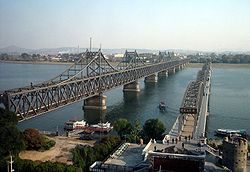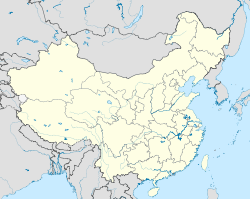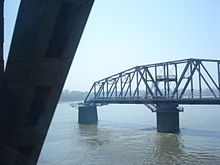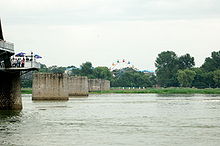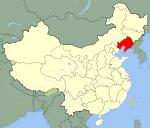- Dandong
-
Dandong
丹东— Prefecture-level city — 丹东市 Location of Dandong in Liaoning Location within China Coordinates (city(2410000)): 40°07′N 124°23′E / 40.117°N 124.383°E Country China Province Liaoning City Seat Zhenxing District Districts and Counties List- Zhenxing District
- Yuanbao District
- Zhen'an District
- Fengcheng City
- Donggang City
- Kuandian Manchu Autonomous County
Government – CPC Dandong Committee Secretary – Mayor Chen Tiexin Area – Prefecture-level city 14,981.4 km2 (5,784.4 sq mi) – Urban 563 km2 (217.4 sq mi) Population (2004)[1] – Prefecture-level city 2,409,697 – Urban 780,414 Time zone China Standard (UTC+8) Area code(s) 415 Licence plates 辽F Website http://www.dandong.gov.cn/ Dandong (simplified Chinese: 丹东; traditional Chinese: 丹東; pinyin: Dāndōng), previously known as Andong and Antung, is a city in Liaoning Province, Northeast China. It lies on the border between China and North Korea, which is marked by the Yalu River, and is the largest border city in China. Also, to the southwest of the city, the river flows into Korea Bay. The city has therefore had a dynamic history because of its strategic location for the northeast's rich natural resources and because of its convenient access to the ocean.
Dandong is designated a major export production center in Liaoning province.[2] Dandong is a port city connected by rail with Shenyang and Sinuiju in North Korea.[3]
The Hushan (Tiger Mountain) Great Wall, the far Eastern end of the Great Wall of China, is located here.[4]
The size of the administrative city (prefecture) is 14,981.4 square kilometres (5,784.4 sq mi);[5] as of 2005, the urban area is 563 square kilometres (217 sq mi) in size and has 780,414 inhabitants. The administrative city covers around 2.4 million inhabitants as of 2009.
Contents
History
Maps and artifacts suggest that the area has been settled since the Zhou Dynasty. The area became known as Andong County (安東縣) in 1876. "安東" means "pacifying the east", reflecting the power projection that China had over Korea at the time. It was occupied by Japan after the start of the first Sino-Japanese War in 1894. During the Manchukuo era it was the capital of Andong Province, one of the fourteen provinces established by Manchukuo. Then, in 1907, it was opened as a treaty port. It adopted its present name on January 20, 1965, which means “red east,” to avoid connotation of its previous name, which was considered imperialistic by some. Recently, the city has been gaining influence in this region of China because of its market with North Korea and the government’s future plans to develop the city into a special “Border Economic Cooperation Zone” for export and import, in order to expand the country’s ability to conduct trade.
Geography
Dandong Climate chart (explanation) J F M A M J J A S O N D 7.1−2−119.51−9187−246154732010108241625227202182820105241449176288−1130−8Average max. and min. temperatures in °C Precipitation totals in mm Source: China Meteorological Administration [6] Imperial conversion J F M A M J J A S O N D 0.328110.434170.745281.858392.968504.275619.980698.682684.175571.962431.146300.53217Average max. and min. temperatures in °F Precipitation totals in inches Dandong is located on the western border of North Korea and the northwest (right) shore of the Yalu River, facing Sinuiju to the southeast. It is situated in the southeast corner of the Liaodong Peninsula, near the mouth of the Yalu River, which empties into the Korea Bay, which is part of the Yellow Sea. There is 120 kilometres (75 mi) of coastline, and islands include Dalu Island (大鹿岛) and Xiaomai Island (小麦岛).
Dandong Prefecture ranges in latitude from 39° 43' to 41° 09' N and in longitude from 123° 22' to 125° 41' E, and at its greatest spans 196 kilometres (122 mi) from east to west and 160 kilometres (99 mi) from south to north.[5] Bordering prefectures are Dalian (SW), Anshan (W), Liaoyang (NW), and Benxi (N).
Climate
The area is home to long winters, and humid, somewhat hot summers, belonging to the humid continental climate regime (Köppen Dwa). Winter usually begins in late November and continues until the end of March (about 4 months), with the most severe cold only lasting for around three weeks in December, January or February. The coldest month, January, averages −7.4 °C (18.7 °F). Spring, though a period of quick warming, is delayed by one month compared to more inland parts of the province, and is somewhat dry until May. The heat of summer is somewhat moderated by the proximity to the ocean; the city's warmest month, August, averages 23.4 °C (74.1 °F), while inland Shenyang averages 24.7 °C (76.5 °F). Precipitation is generous, too, further exemplifying the maritime influence.
For the city proper, the annual mean temperature is 8.94 °C (48.1 °F), and the total precipitation is 926 millimetres (36 in), but within the prefecture, annual means can be as low as 6.8 °C (44.2 °F), while precipitation ranges from 881.3 to 1,087.5 millimetres (34.70 to 42.81 in).[5]
Climate data for Dandong (1971−2000) Month Jan Feb Mar Apr May Jun Jul Aug Sep Oct Nov Dec Year Average high °C (°F) −2.3
(27.9)1.1
(34.0)7.2
(45.0)14.6
(58.3)20.0
(68.0)24.1
(75.4)26.7
(80.1)27.8
(82.0)23.8
(74.8)16.9
(62.4)7.7
(45.9)0.1
(32.2)14.0 Average low °C (°F) −11.4
(11.5)−8.6
(16.5)−2.4
(27.7)4.1
(39.4)10.2
(50.4)15.9
(60.6)20.3
(68.5)20.1
(68.2)13.7
(56.7)6.3
(43.3)−1.2
(29.8)−8.3
(17.1)4.9 Precipitation mm (inches) 7.1
(0.28)9.5
(0.374)18.1
(0.713)46.2
(1.819)73.1
(2.878)107.5
(4.232)251.6
(9.906)217.8
(8.575)104.6
(4.118)49.0
(1.929)28.4
(1.118)12.7
(0.5)925.6
(36.441)% humidity 55 53 60 66 72 82 89 86 78 69 63 59 69.3 Avg. precipitation days (≥ 0.1 mm) 3.8 3.6 5.0 8.2 9.8 11.7 15.6 12.0 7.9 6.8 6.2 3.9 94.5 Sunshine hours 195.0 199.7 228.4 234.0 243.4 212.9 159.3 199.5 225.5 215.5 171.7 174.0 2,458.9 Source: China Meteorological Administration [6] Administrative divisions
Dandong is divided into 3 districts, 2 towns and one autonomous county:
Map 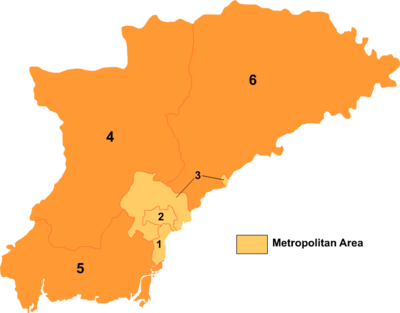
# Name Hanzi Hanyu Pinyin Population (2003 est.) Area (km²) Density (/km²) 1 Zhenxing District 振兴区 Zhènxīng Qū 380,000 80 4,750 2 Yuanbao District 元宝区 Yuánbǎo Qū 180,000 81 2,222 3 Zhen'an District 振安区 Zhèn'ān Qū 190,000 669 284 4 Fengcheng City 凤城市 Fèngchéng Shì 580,000 5,518 105 5 Donggang City 东港市 Dōnggǎng Shì 640,000 2,496 256 6 Kuandian Manchu
Autonomous County宽甸满族自治县 Kuāndiàn Mǎnzú
Zìzhìxiàn440,000 6,186 71 Demographics
In the latest official census of 2000, Dandong’s total resident population (which includes the districts of Zhenxing, Yuanbao, and Zhen’an) was 780,414 people, while Dandong proper had a total population of 2.4 million. In 2005, the resident population was approximated to be 751,914 with a floating population of 176,926, for a total of 928,840. However, the non-agricultural (urban) population is said to consist of only 79.52% of the resident population (597,930). It is unclear what the floating population consists of or where they live, but it is suspected that most of the migrant population is people from the country-side looking for work, local and foreign businessmen, and students. In 2000, there were 244,430 family households (with a pop. of 741,882) and 4,955 collective households (with a pop. of 38,532). The demographic ratio of men to women was 99.52 males to every 100 females. Also, 81.61% of the population was above 15 years of age; thus, 18.39% of the population was under 15 in the year 2000.
The ethnic Han people make up approximately 87.6% of the city’s population. The Manchus are the second most populous ethnic group and officially make up 9.6% of the population. The Manchu minority group has become so acculturated into the Han majority that there remains little or no distinction between the two, although a number of Manchu words have remained in the local lexicon. The Hui make up the next most populous minority at 1.5%. Although not recognised by the city's official census figures, there is a thriving Korean minority group estimated at 20-30,000 ethnic Koreans which would place them as the second largest minority in the city (at around 2.16%+ of the total estimated pop. for 2004). A number of signs and advertisements are in both Mandarin and Korean and there are many Korean restaurants and shops as well as some Korean churches, schools and other cultural institutions.
Economy
The total GDP of the city of Dandong is 9.52 Billion yuan in year 2009 (ranked 40th out of the 58 cities and counties in Liaoning province). The GDP per capita of the city of Dandong is 12414 Yuan in 2009 (ranked 52nd out of all 58 cities and counties in Liaoning province).[7]
China handles roughly 40% of North Korea’s worldwide export trade ($1.58 of 4 billion USD) and “half of the bilateral commerce with China goes through Dandong” which “imports $468 million [USD worth of product], according to its Ministry of Commerce.” Dandong’s annual resident per capita wage income for 2004 was somewhere between ¥9,500 and ¥12,237 RMB and the city’s GDP was 3.77 billion USD. The port of Dandong is being developed into the second major international logistics center of Liaoning and has become a notable alternative to the port of Dalian. Interestingly, the city had “5.86 million tourists” in 2004, of which 16,000 of those traveled into North Korea; another 81,000 of those were from overseas and pumped $27.54 million USD into the economy. During 2004, “the total tourism income was 4.02 billion Yuan [RMB],” and this was an increase of almost 33% from the previous year.[8]
Development Zones
Dandong Border Economic Corporation Zone was approved as a national-level development zone in 1992. It is located on the bank of Yalu River, opposite the North Korean city of Sinuiju. It encourages the following industries: electronic information, machine manufacturing, bio-pharmaceuticals, among others.[9]
Dandong Qianyang Economic Development Zone was first approved by Dandong City as a Special Economic Zone, in 1994 by Liaoning Province as Liaoning Dandong Qianyang Economic Development Zone (LDQEDZ). In July 2009, the development of the Liaoning Coastal Economic Belt was listed as a national strategy. Qianyang Town, situated at the eastern tip of the Belt is now an important component of Dandong’s coastal development, and has an opportunity to demonstrate its strategic position.[10]
Infrastructure
Railways
Trains from Dandong to Shenyang are available several times a day with night trains to Beijing, Dalian, Changchun and Qingdao. From Dalian, the train takes a slow route of almost 10 hours. It is also possible to take the train to Pyongyang, North Korea and Moscow, with the proper visas.[3]
Road
From the long-distance bus station it takes about 10 hours to get to Beijing, four hours to Dalian and Tonghua, and three hours to Shenyang.[3]
Air
Flights to and from Dandong Airport are limited, but one can always fly in/out of Dalian or Shenyang and then take the train or bus to/from Dandong. The airport is located 13 miles west of town and an airport shuttle is available. Domestic flights are available to Beijing, Guangzhou, Qingdao, Sanya, Shanghai and Shenzhen.[2]
Ports and waterways
The Port of Dandong is located on the right bank at the mouth of the Yalu River. It is bordered by the Yellow Sea in the south and is separated from the North Korea in the east. It was set up as a trading port in 1907. Since large-scale construction began in the mid 1980s, the Port, together with the ports at Dalian and Yingkou, has become an important distributing center in northeast China.[4]
Landmarks
The city is across the river from Sinŭiju, North Korea. The two cities are connected by the Sino-Korea Friendship Bridge (中朝友谊桥, also called the China-Korea Friendship Bridge). Another major landmark is Hushan Great Wall (虎山长城), which marks the eastern end of the start of the Ming Dynasty's extension to the Great Wall. Other interesting tourist spots include: a museum dedicated to the "War to Resist US Aggression and Aid Korea" (also known as the Korean War) and Jinjiang mountain (锦江山) that is now the city's biggest park, but used to be a Chinese army lookout.
Places
Tourists can rent speed boats or passenger boats to approach the border and get a closer look at the North Korean city of Sinŭiju. North Koreans often gather close to the river's edge, waving to foreigners as they cruise by. There is a rarely used ferris wheel in Sinŭiju that tourists are able to see from across the Yalu River. This is a highlight for tourists wishing to catch a glimpse of North Korea.
Friendship cities
Dandong is a Sister City with the following cities:
 Tokushima, Japan - (1991)
Tokushima, Japan - (1991) Doncaster, England, United Kingdom - (1988)
Doncaster, England, United Kingdom - (1988) Wilmington, North Carolina, USA - (1986)
Wilmington, North Carolina, USA - (1986)
References
- ^ Dandong China-Dandong Briefing-Population and Employment
- ^ a b "Dezan Shira & Associates". Dezan Shira & Associates. 2009. http://www.dezshira.com. Retrieved 2009-02-08.
- ^ a b c "China Briefing Business Reports". Asia Briefing. 2009. http://shopping.china-briefing.com/index_eproduct_view.php?products_id=21. Retrieved 2009-02-08.[dead link]
- ^ a b "China Expat city Guide Dalian". China Expat. 2008. http://www.chinaexpat.com/list/88. Retrieved 2009-02-08.
- ^ a b c "中国丹东-丹东概貌导航-自然地理" (in Simplified Chinese). Dandong Municipal Government. 15 June 2005. http://www.dandong.gov.cn/2106/jt_dds_zf_ddgm_dh.nsf/0/F4313551FB0481BD482570460021A7C6?OpenDocument. Retrieved 2011-04-17.
- ^ a b "中国地面国际交换站气候标准值月值数据集(1971-2000年)" (in Simplified Chinese). China Meteorological Administration. http://cdc.cma.gov.cn/shuju/index3.jsp?tpcat=SURF&dsid=SURF_CLI_CHN_MUL_MMON_19712000_CES&pageid=3. Retrieved 2010-11-01.
- ^ Liaoning Statistical Yearbook. []. 2009.
- ^ "China Briefing Guide". Dandong Municipal People's Government. 2005. http://www.dandong.gov.cn/. Retrieved 2009-03-22.
- ^ RightSite.asia | Dandong Border Economic Corporation Zone
- ^ China Liaoning Business Guide
External links
- Government website (English)
- Administrative Committee of Dandong Border Economic Cooperation Zone
- Dandong Expat website - Travelling in Dandong (English)
- Dandong Guide - information for tourists such as hotels, restaurants, sightseeing, transport, etc. (English)
Liaoning topics General Geography Education Visitor attractions Mukden Palace • Early Qing Tombs • Wunu Mountain City • Anshan Jade Buddha • Bijia Mountain • DalianLiaoning Province county-level divisions Shenyang: Shenhe District · Huanggu District · Heping District · Dadong District · Tiexi District · Sujiatun District · Dongling District · Shenbei New Area · Yuhong District · Xinmin City · Faku County · Liaozhong County · Kangping County · Hunnan New Area*
Dalian: Xigang District · Zhongshan District · Shahekou District · Ganjingzi District · Lüshunkou District · Jinzhou District (Jinzhou New Area*) · Wafangdian City · Pulandian City · Zhuanghe City · Changhai County
Anshan: Tiedong District · Tiexi District · Lishan District · Qianshan District · Haicheng City · Tai'an County · Xiuyan Autonomous County
Fushun: Shuncheng District · Xinfu District · Dongzhou District · Wanghua District · Fushun County · Xinbin Autonomous County · Qingyuan Autonomous County
Benxi: Pingshan District · Xihu District · Mingshan District · Nanfen District · Benxi Autonomous County · Huanren Autonomous County
Dandong: Zhenxing District · Yuanbao District · Zhen'an District · Fengcheng City · Donggang City · Kuandian Autonomous County
Jinzhou: Taihe District · Guta District · Linghe District · Linghai City · Beizhen City · Heishan County · Yi County
Yingkou: Zhanqian District · Xishi District · Bayuquan District · Laobian District · Dashiqiao City · Gaizhou City
Fuxin: Haizhou District · Xinqiu District · Taiping District · Qinghemen District · Xihe District · Zhangwu County · Fuxin Autonomous County
Liaoyang: Baita District · Wensheng District · Hongwei District · Gongchangling District · Taizihe District · Dengta City · Liaoyang County
Panjin: Xinglongtai District · Shuangtaizi District · Dawa County · Panshan County
Tieling: Yinzhou District · Qinghe District · Diaobingshan City · Kaiyuan City · Tieling County · Xifeng County · Changtu County
Chaoyang: Shuangta District · Longcheng District · Beipiao City · Lingyuan City · Chaoyang County · Jianping County · Harqin Autonomous County
Huludao: Longgang District · Lianshan District · Nanpiao District · Xingcheng City · Suizhong County · Jianchang CountyChina – North Korea border crossings Categories:- Cities in Liaoning
- Prefecture-level divisions of Liaoning
- China–North Korea border crossings
Wikimedia Foundation. 2010.

